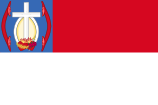The flag of Easter Island (Rapa Nui: Te Reva Reimiro or Te Reva Rapa Nui) is the flag of Easter Island, a special territory of Chile. It was first flown in public alongside the national flag on 9 May 2006.[2]
 | |
| Use | Civil and state flag |
|---|---|
| Proportion | 5:8 |
| Adopted | 9 May 2006 |
| Design | A white flag with a red reimiro in the centre |
 | |
| Use | Former flag |
| Proportion | 3:4 |
| Adopted | 1880 |
| Relinquished | 1899 |
| Design | A white flag with a red reimiro in the centre and four black Tangata manu (bird-man) figures in each corner |
 | |
| Use | Former flag |
| Proportion | 2:3 |
| Adopted | 1899 |
| Relinquished | 1902 |
| Design | A horizontal bicolor of red and white with the blue square ended on the upper hoist-side corner of the red band bearing the Hearts of Jesus and Mary, a cross, a miter and vertical red reimiros surrounding.[1] |
Depiction
editIt is a white flag featuring in center a reimiro (a wooden pectoral ornament once worn by the people of Rapa Nui) painted in red (mana), a symbol of power, with two anthropomorphic figures at its edges, representing the Ariki ('chiefs, nobles').[3]
A variant distinctively features four black Tangata manu ('bird-man') at each corner of the flag.[citation needed]
History
editThe Te Reva Reimiro was created by the local population in 1880 for the island to adopt the apparatus of a modern state and hold a state-to-state dialogue with Chile, which eventually annexed the island in 1888.[3]
For many years, the flag was unofficially used by the island's Polynesian population to represent their island, however the official flag was the white and gold flag of the "Municipality of Easter Island". In 2006, it was upgraded to a "Special Territory" and optional use of the Rapa Nui name was allowed in government documents for the first time, with the Reimiro flag adopted as the entity's flag.[2]
References
edit- ^ "Bandera de la Isla de Pascua". Revista Sucesos (17): 15. 19 December 1902. p. 383. Retrieved 8 October 2022.
- ^ a b Crouch, Alex (6 April 2015). "Easter Island's Flag". The Flag Institute. Retrieved 20 June 2020.
- ^ a b Cornejo, Cristobal; Salinas, Julio Hotu (6 September 2011). "Campaña promueve uso de banderas de pueblos originarios: Sepa qué significan". El Ciudadano (in Spanish). Retrieved 20 June 2020.